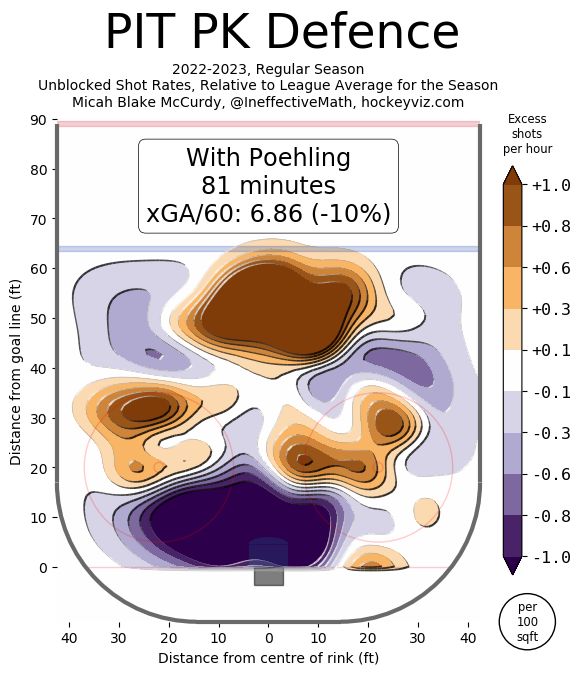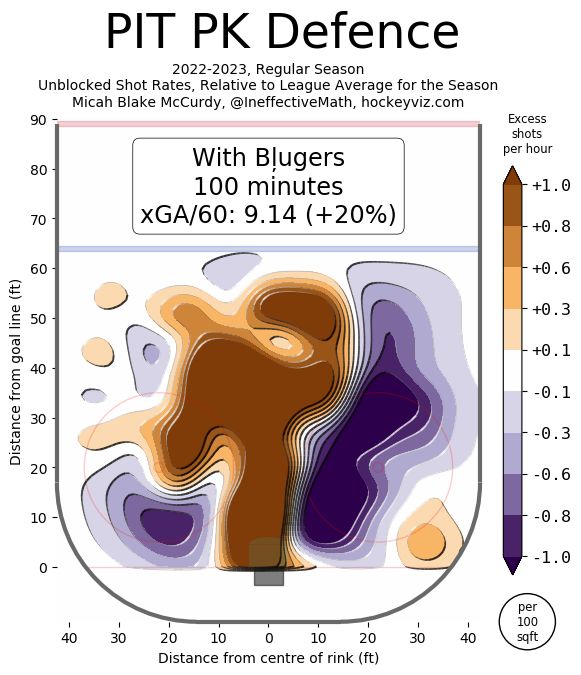SAN JOSE, Calif. -- It's risky business for any sports franchise to effectively tie itself to players that aren't among the best of the best. When I say best of the best, I'm talking about the top 10-15% of players, at least as far as the NHL is concerned. No disrespect to the players below that threshold, but they're typically much easier to find and replace, have shorter shelf lives, and are more susceptible to swings in performance from season to season.
Now, that's not to say you don't commit yourself to a player like Rickard Rakell when the opportunity presents itself, but the further and further down the lineup you go, the returns are increasingly diminished when you stay in bed with a player past the point of logic and reason.
The Penguins are nearing that point with 28-year-old Teddy Blueger. They've got an interesting and perhaps difficult decision to make on what to do with Blueger, who will become an unrestricted free agent this coming offseason.
It's been a downright disappointing 2022-23 season for Blueger. After missing nearly a month of games right out of the gates due to injury, Blueger has become an offensive black hole, scoring just one goal to go along with seven assists in 38 games. I'm not typically in the business of cherry-picking like this, but Blueger's production looks even worse when considering three of his seven assists came in the same game against the Flyers on Nov. 25.
For a fourth-line center, that's not the end of the world if they're providing considerable value in the defensive zone. In Blueger's case, his even-strength defensive impacts have remained good, but not quite at the level he established himself at over each of the previous three seasons. His effectiveness on the penalty-kill hasn't been anywhere close to previous levels.
That's just not going to cut it at a $2.2 million cap hit.
What's strange is that Blueger actually scored at a decent clip during his first two seasons in the league considering his role. He was never going to be some big bottom-six producer or driver of offense, but it seemed as if he had the foundation to provide respectable outputs in both departments.
Blueger's performance for most of this season is likely as low as it's going to get. There's really only room for him to go up. But does that mean the Penguins should re-sign him over the offseason due to familiarity and hopes he could rediscover his former impact?
I wouldn't.
The problem is that, even if you expect Blueger to rebound from this season, he's still a fourth-line player nearing his 30s. Ideally, every NHL franchise -- just as the Penguins have done to this point with Blueger -- drafts and develops a good chunk of their depth players, only to move on from said players after enjoying their entry-level contract and perhaps another short-term contract before the cycle repeats itself.
Now's about that time in the cycle to move on from Blueger.
Despite burning through draft picks in trades over the years, the Penguins still have a viable in-house candidate to step into Blueger's role next season: Ryan Poehling.
Poehling, 24, was acquired this past offseason in the Jeff Petry trade. At the time of the trade, I erroneously and unfairly dubbed Poehling as nothing more than a throw-in and warm body. That's been anything but the case to this point.
Poehling has been in and out of the lineup over the past couple months due to a nagging upper-body injury, but he's easily been the best member of the Penguins' fourth line when he plays, whether that be on the wing or at center.
Right off the bat blade, Poehling's production this season doesn't stand out a whole lot. In 38 games he's scored five times and picked up six assists, but when adjusting for ice time at 5-on-5, he's putting up 1.46 points per hour, which is a solid-if-unspectacular rate for a depth forward. For comparison's sake, Blueger is producing 0.97 points per hour at 5-on-5 and Brock McGinn is at 1.09 per hour.
And while I'm not led to believe it's all that repeatable over multiple seasons, it is worth noting that Poehling's 2.21 points per hour while short-handed ranks 13th among all NHL skaters to play at least an hour on the penalty-kill.
Poehling's production rates check out. But the Penguins need to be prepared for those rates to pull back, just in case. What's even more important is how Poehling impacts possession at both ends of the rink during even-strength action, and how he's performed on the penalty-kill.
Regarding his influence on his team's ability to create quality offensive chances at even-strength, Poehling's isolated impact ranks in the 53rd percentile, per JFreshHockey. Blueger ranks in the 23rd percentile this season, and hasn't topped the 26th percentile in any of the previous three seasons.
Defensively at even-strength is the only area in which Blueger outshines Poehling. The former's isolated impact in the defensive zone ranks in the 74th percentile, while the latter's ranks in the 59th percentile. Overall, though, Poehling's play-driving ability trumps Blueger's. Bottom-six forwards who are above-average offensively and defensively aren't all that easy to come by, so Poehling immediately becomes intriguing for that alone.
But it's Poehling's work on the penalty-kill that has me convinced the Penguins should seriously consider letting Blueger walk over the offseason.
Here's where and how frequently the Penguins are letting opposing power plays shoot with Poehling out on the ice for the kill, per HockeyViz:

HockeyViz.com
The darker the yellow, the more unblocked attempts taken from that area, relative to league-average. The darker the purple, the fewer attempts taken from that area, relative to league-average.
Now, Poehling doesn't get to take all of the credit here, but the Penguins are doing an outstanding job of keeping opposing power plays away from the net-front and slot area, instead forcing them to fire low-danger attempts from the middle of the point.
Compare that to the Penguins' penalty-kill results with Blueger out there, and ...

HockeyViz.com
The darker the yellow, the more unblocked attempts taken from that area, relative to league-average. The darker the purple, the fewer attempts taken from that area, relative to league-average.
... yeah. That's a tough scene for someone whose perceived value mostly comes from the penalty-kill.
The one concern I have about this proposition, though it is somewhat minimal, is that Poehling is winning just 42.8% of his faceoffs this season and has a 44.8% success rate at the dot for his career. Blueger is at 50% this season and 48.6% for his career. Those differences aren't nothing, but I suspect they're offset by the things Poehling is bringing to the table that Blueger simply isn't.
Poehling will be a restricted free agent this coming offseason, so the Penguins aren't at risk of losing him if they'd like to hang onto him. He will be due a $787,500 qualifying offer for the Penguins to retain his rights.
You'd think Blueger's salary is due for a pullback, but from what I've heard around the league, he's still an interesting piece to other teams. There are certainly general managers out there who would take a flyer on Blueger around a $2 million cap hit, and that's something the Penguins don't need to get involved in, quite frankly.
Poehling isn't the fastest guy, but he plays the game with a lot of pace and it translates well toward the style that Mike Sullivan requires of his bottom six. His even-strength defensive work isn't on par with Blueger, but he's making up for every bit of it with his offensive impact and strong penalty-kill results.
Poehling taking over for Blueger next season doesn't come without risk, but I don't see it being anywhere near as risky as being the team to give Blueger his next contract and hoping he turns it around despite nearing an age when many players of his caliber start to fall off.

